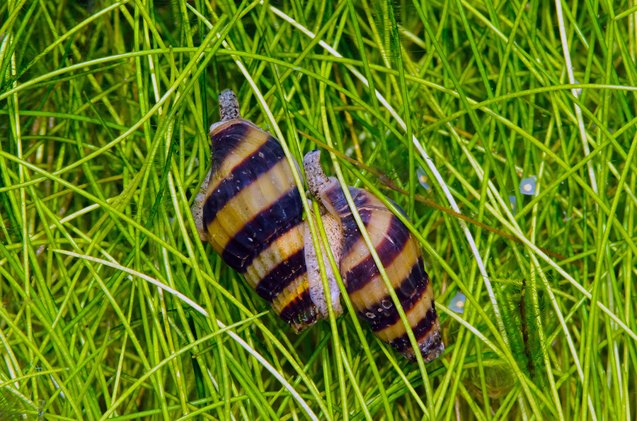Meet the Snail Assassin: Your Solution to Pest Snails

Every aquarium keeper has run into the problem of pest snails, at least once. Your neat little pond snails, Ramshorn snails, or Malaysian trumpet snails, have started taking over your tank. You are kept up at night wondering if they will eventually take over your home, that you’ll wake up to find them reading your paper, enjoying your coffee, and kissing your husband or wife. Okay, maybe not quite THAT bad, but there are solutions, and one of the most interesting to watch solutions come in the form of… another snail!
Assassin snails, scientifically known as “Clea Helena,” are a black and yellow striped snail with an elongated shell. These snails are carnivores, and so they eat pest snails in the tank, along with decaying matter such as fish food. They enjoy meaty foods like catfish pellets if live foods are scarce.
Related: Top 5 Invertebrates to Hire For Your Freshwater Cleanup Crew
Clea Helena will make quick work of your pest snail problem, ripping them from their shells for a snack, and leaving nothing behind but a cemetery of empty shells in their wake. It will be hard to believe that your tank was once teeming with pest snails so thick you couldn’t see the glass.
Assassin snails, which hail from Southeast Asia, are a pretty calm snail considering their job and name. They don’t eat plants, and so can be kept in just about any aquarium. Assassin snails are whelks, which typically are found in saltwater conditions. But assassin snails are solely freshwater snails, and have become increasingly more popular in the aquarium trade due to their striking appearance and ability to control pest snails with minimal effort on the keeper’s part.
Related: Tips for Keeping Your Aquarium Water Quality High
Assassin snails are exceptionally tolerant of a wide range of water conditions, while they come from fast moving streams; they seem unscathed by any tank environment and can live with just about any fish. They scavenge for decaying matter in the tank, and so along with their ability to control snail populations, they are also useful in tank maintenance as well.
Their breeding practices are extremely interesting. Assassin snails are slow breeders, so they are unlikely to become a pest. The male fertilizes the eggs, which the female keeps inside of her until just before hatching, when she lays the eggs in a transparent glob and within an hour or so little assassins have been born. The babies will then hide beneath the substrate for up to six months before they will be seen at the surface scavenging for food like their parents.
If you have a snail problem, or even if you don’t, assassin snails are one of the coolest inverts to put into a freshwater aquarium. They can help keep your tank clean, free of pest snail issues, and amuse you all at the same time. After all, how many times can you say that you have real live assassins living in your home? And of course, you have to keep the pest snails from taking over the world!
Summer Davis is the mom of three kids, four dogs, and several tanks of fish. She boasts a passion for all animals, whether they are in the water or on land. This fish aficionado has kept many different species in her time, but holds a special place in her heart for wild and domestic bettas. When she’s not talking about fish, Summer “spins” her extra time as the director of a baton twirling organization.

Amy Tokic, Editor of PetGuide.com, is a passionate animal lover and proud pet parent of Oscar, a Shih Tzu/Chihuahua cross, and Zed, a Japanese Chin. Her love of animals began in kindergarten, when she brought her stuffed dog Snoopy into class with her every day. Now, she writes about her adventures in pet ownership and tirelessly researches products, news and health related issues she can share with other animal enthusiasts. In her free time, Amy loves perusing used book and record stores, obsessing over the latest pet products available and chasing squirrels with wild abandon (a habit attributed to spending too much time with her pooches).
More by Amy Tokic
























